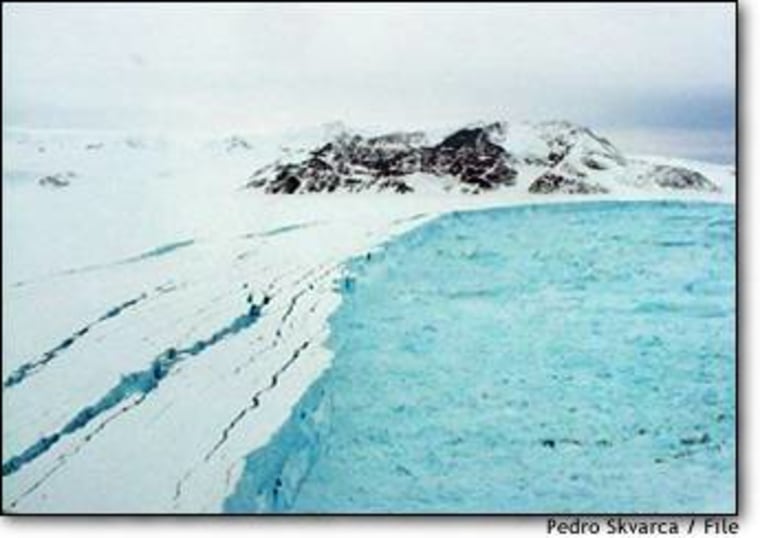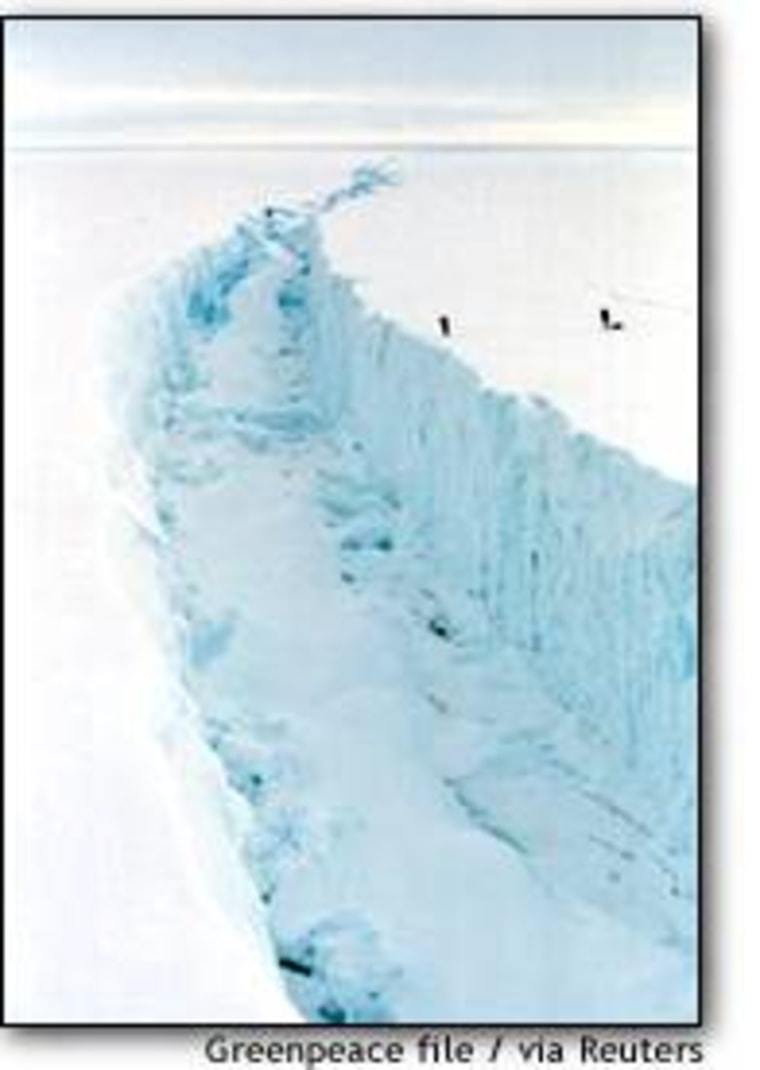A massive Antarctic ice shelf has collapsed into the sea, shattering into thousands of icebergs and alarming researchers by the speed with which the process unfolded. Described by one researcher as “staggering,” the rapid collapse offered fuel for the debate over whether global warming is to blame.
U.S. AND BRITISH government agencies confirmed the collapse of what’s known as the Larsen B ice shelf. Some 1,255 square miles of the ice shelf disintegrated between Jan. 31 and March 7, the U.S. National Snow and Ice Data Center reported Tuesday.
“The shattered ice formed a plume of thousands of icebergs adrift in the Weddell Sea,” the center said, adding that over the past five years, Larsen B lost nearly twice that amount and is now about 40 percent the size of what it used to be.
Before it broke apart, the shelf was 650 feet thick and about the size of Rhode Island.
Scientists with the British Antarctic Survey first predicted in 1998 that it would eventually collapse, and satellite images over the years suggested as much. The process accelerated over the last month, with the single largest piece calving on March 5.
720 BILLION TONS
David Vaughan, a glaciologist with the British Antarctic Survey, noted that since the 1998 prediction, “warming on the peninsula has continued and we watched as piece by piece Larsen B has retreated.”
“We knew what was left would collapse eventually,” he said in a statement, “but the speed of it is staggering.” It’s hard to believe, he said, that 720 billion tons “of ice sheet has disintegrated in less than a month.”
The U.S. center noted that 720 billion tons is enough ice for 290 trillion 5-pound bags.
The British Antarctic Survey said its scientists would be researching when such an event last happened and which ice shelves are threatened in the future. Earlier studies found four other ice shelves had been retreating in recent years.
The researchers emphasized that ice shelves themselves would not raise sea levels because they were already floating in water. However, because shelves hold back ice sheets on the continent, their collapse could allow ice on the ground to slowly move into the sea, thereby raising sea levels over time.
‘CLOSER TO THE LIMIT’
Ted Scambos, a glaciologist with the National Snow and Ice Data Center, said in a statement that the Larsen B collapse “gave us the information we need to reassess the stability of ice shelves around the rest of the Antarctic continent. They are closer to the limit than we thought.”
“Loss of ice shelves surrounding the Antarctic continent could have a major effect on the rate of ice flow off the continent,” Scambos added.
The center, located at the University of Colorado, noted that the next shelf to the south, the Larsen C, “is very near the stability limit, and may start to recede in the coming decade if the warming trend continues.”
“More importantly,” it said, is what might happen with the giant Ross Ice Shelf, the main outlet for several major glaciers draining the West Antarctic Ice Sheet — which is 6,000 feet thick, covers an area the size of Mexico and contains enough water to raise global sea levels by 15 feet.
“The warmest part of the giant Ross Ice Shelf is in fact only a few degrees too cool in summer presently to undergo the same kind of retreat process,” the center said.

GLOBAL WARMING DEBATE
Both the U.S. and British agencies attributed the collapse and other retreating shelves to warmer temperatures over the last half century.
That would fit in nicely with arguments made by environmentalists and many scientists that manmade emissions of greenhouse gases like carbon dioxide are causing global warming. Greenpeace, for one, called the collapse “a harbinger of global warming.”

Others, including some scientists, say it’s possible that any warming is due to natural shifts, not manmade causes, and that further studies are needed before taking global action to reduce emissions.
The agencies did not enter the debate over what has caused the warming around the Antarctic Peninsula.
The British Antarctic Survey limited its observation to earlier studies that found the peninsula has warmed by 4.5 degrees Fahrenheit over the last 50 years — much faster than global warming worldwide or even in other parts of Antarctica. The peninsula is the Antarctic area closest to southern Argentina and Chile.
The National Snow and Ice Data Center said studies had estimated that Larsen B had existed for at least 400 years and probably since before the end of the last major ice age 12,000 years ago.
“This is the largest single event in a series of retreats by ice shelves in the peninsula over the last 30 years,” the center said, attributing them to “a strong climate warming in the region.”
In comments to MSNBC.com, Scambos was careful not to tie the collapse to manmade emissions of greenhouse gases, and noted that computer models actually predicted different regional effects from those gases.
But he added that the collapse was so sudden in geological time that it’s not clear it was due to natural causes either.
What’s needed, he said, are improved computer models, more sampling of ice cores for climate changes and continued tracking of ice shelves and sea ice.
“The tools are there,” he said, “we need to apply them.”
COOLING IN SOME AREAS?
Other studies have actually suggested some Antarctic areas might be cooling.
One study reported new measurements showed the ice in West Antarctica was thickening, reversing earlier estimates that the sheet was melting. The Antarctica Peninsula extends from West Antarctica.
The researchers said the thickening, if not merely part of some short-term fluctuation, represented a reversal of the long retreat of the ice.
Another recent study concluded that Antarctica’s harsh desert valleys — long considered a bellwether for global climate change — have grown noticeably cooler since the mid-1980s.
Air temperatures recorded continuously over a 14-year period ending in 1999 declined by about 1 degree Fahrenheit in the polar deserts and across the White Continent, that paper said.
Scambos questioned that data but also acknowledged that “the only area showing an unambiguous warming trend is the Antarctic Peninsula.”
SEPARATE ICEBERG breaks
In another development on Antarctica, the National Ice Center on Monday confirmed reports that a mammoth iceberg — some 40 by 53 miles in size — had broken away from a section of the continent in the Amundsen Sea.
InsertArt(2050772)The iceberg was designated B-22 and is larger than the state of Delaware. It remained relatively close to the continent and was not described as an imminent threat to shipping.
Icebergs are named for the section of Antarctica where they are first sighted. The B designation covers the Amundsen and eastern Ross seas and the 22 indicates it is the 22nd iceberg sighted there by the National Ice Center.
Scambos said the B-22 was part of a regular cycle of iceberg creation off Antarctica, and not tied to warming. A much larger iceberg was created off the Ross ice shelf two years ago, he added.
The B-22 is likely to get grounded near the continent, Scambos said, but could last quite a few years.
The Associated Press contributed to this report.